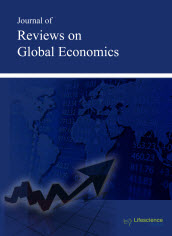jrge
Abstract - Real Risk-Free Rate, the Central Bank, and Stock Market Bubbles
|
|
Abstract: The central bank acts as a social planner, and adjusts the real risk-free rate of return to correct any mispricing in the stock market so that the emergence of positive or negative bubbles is avoided. The analysis shows that the central bank must raise the risk-free rate in the case of a positive bubble, and vice versa. Moreover, the central bank should intervene in the stock market even if it does not have perfect information about the bubble. This is because the sequential dividend yields in the pricing equations are stationary. Thus, even the delayed reaction of the central bank prevents the fundamental value and the equilibrium price from drifting apart for extended periods. Keywords: Real Interest Rate, Monetary Policy, Portfolio Choice. |
Abstract - Effects of Market Reforms and External Shocks on Indian Stock Indices: Evidence on Structural Breaks and Weak-Form Efficiency
|
|
Abstract: This study explores stock market efficiency in India after allowing for potential structural changes induced by reforms processes and/or external shocks. The endogenous determination of structural break dates, using mostly Clemente, Monta˜n´es, & Reyes (1998) (CMR) methodology, allows us to identify important events in this respect. External shocks such as occasional stock market scams, policy and political regime changes, oil price shocks and the effect of global market meltdowns have caused abrupt or one time changes in the series mean (additive outlier model), while the reforms processes stand out to be the single most important cause for the gradual shifts in the level of stock indices (innovation outlier model). This underlines the importance of institution building and the domestic policy stance in countering external shocks. Keywords: Indian Stock Market, Efficient Market Hypothesis, Random Walk, Mean-Reversion, Structural Break, Unit Root Test. |
Abstract - Voluntary Corporate Governance Disclosure Innovative Evidence: The Case of Jordan
|
|
Abstract: This paper aimed to assess the corporate governance voluntary disclosure level and the impact of a set of corporate governances (CG) attributes on the level to which corporate governance voluntary disclosure is conducted in Jordan. Another objective was to determine if Jordanian industrial listed corporations adhere to and disclose good CG practices voluntarily, and if they do, to determine the factors influencing such disclosure. This study employed 61 industrial listed firms for the years 2010-2014. The research developed a general voluntary CG disclosure index composing of 15 Jordanian Corporate Governance Codes and gauged the relationship via pooled OLS and regression method. The results indicated that the proposed Jordanian Corporate Governance Index (JCGI) enhanced voluntary corporate governance disclosure among Jordanian listed firms over the examined years. They also showed varying levels of CG disclosures in different scenarios; 1) it is lower in firms with higher managerial ownership and 2) higher relative to the independent directors’ proportion on the board, audit firm size, and audit committee presence with institutional ownership. Evidence on the compliance level towards the CG code in Amman Stock Exchange is unique and the study is distinct as it provides a pioneering evidence of the achieved compliance level. Keywords: Jordan, corporate governance codes, voluntary corporate disclosure, governance index, industrial sector. |
Abstract - European Insurance Markets in Face of Financial Crisis: Application of Learning Curve Concept as a Tool of Insurance Products Innovation – Discussion
|
|
Abstract: The paper aims to present the results of an assessment of development of insurance sector in chosen European countries like Poland, UK, Germany and France over the financial crisis especially from product’s innovation point of view. The comparison between the level of taxonomic measures in two points in time let the Authors to write main conclusion that insurance markets have been not so innovative in chosen countries. The level of innovations have been especially law in terms of insurance offer (Products). The first part of the paper ends with a short description of so called new risks that impose a level of innovations within an insurance sector. The second part contains a discussion about possibility of using learning curve concept for the process of insurance product innovation especially products “without claims history”. Keywords: Multidimensional data analysis, insurance innovation, new risks, insurance markets. |






















